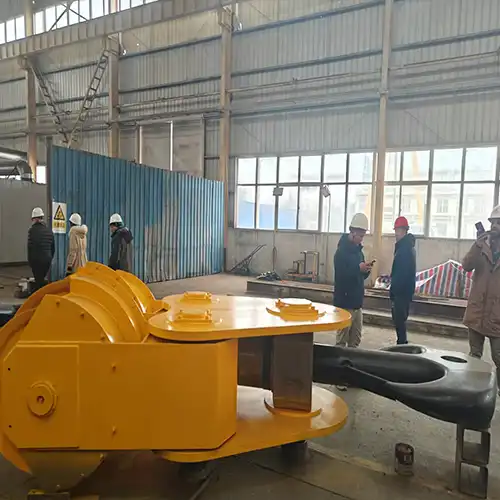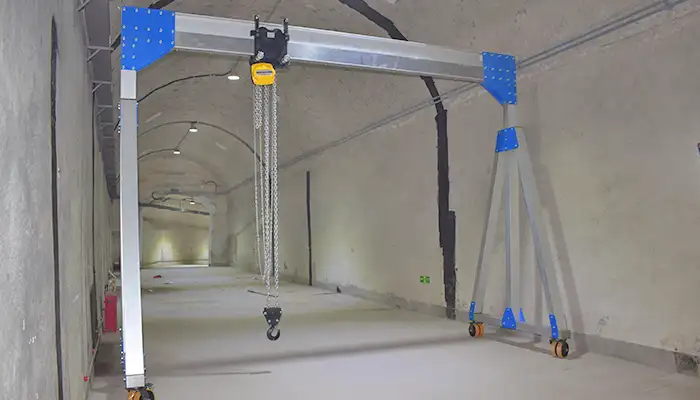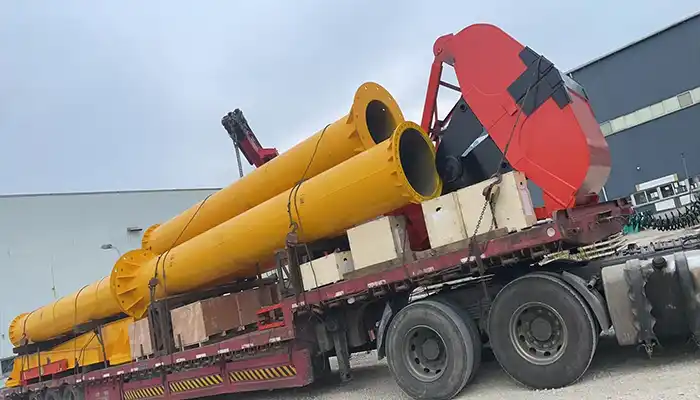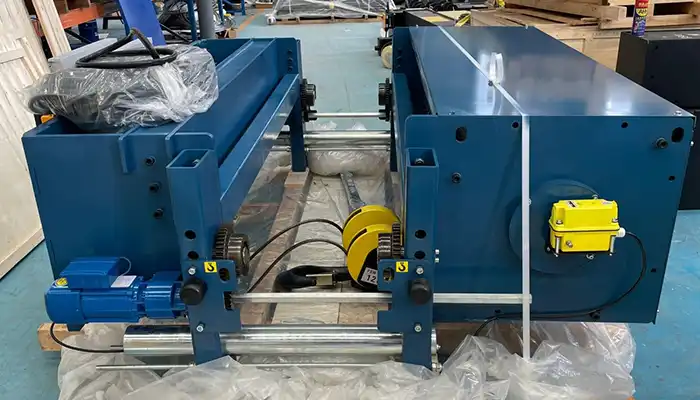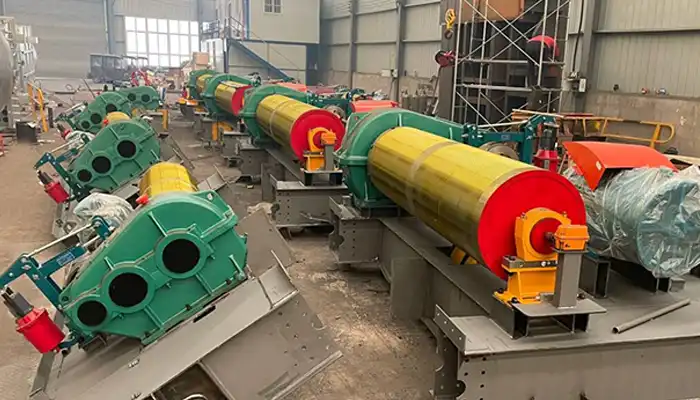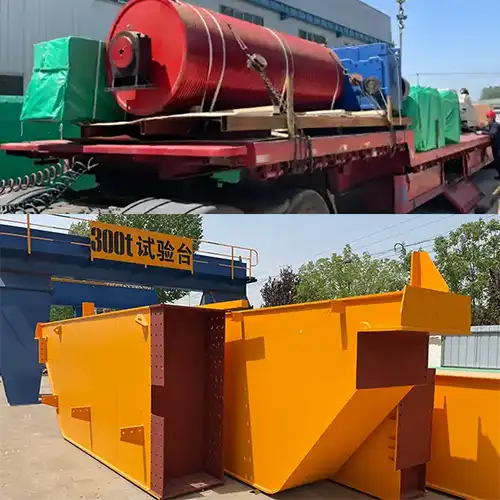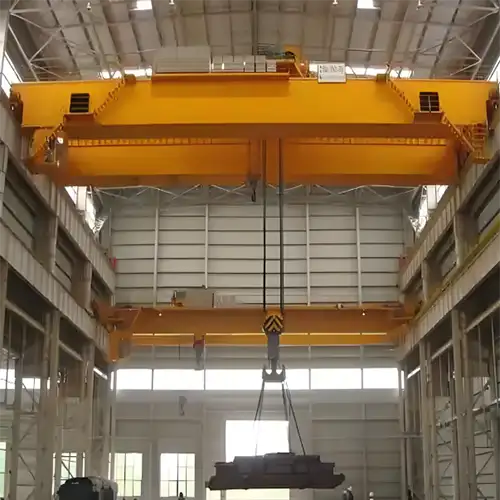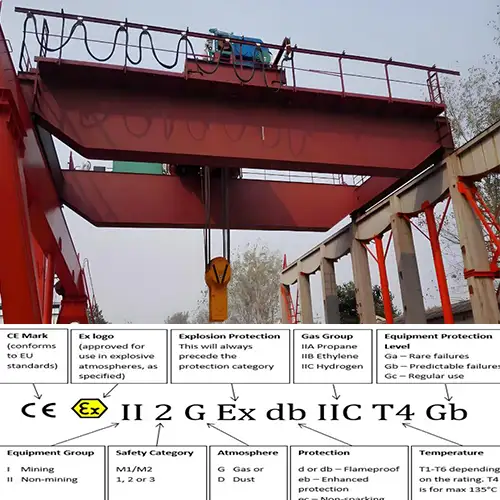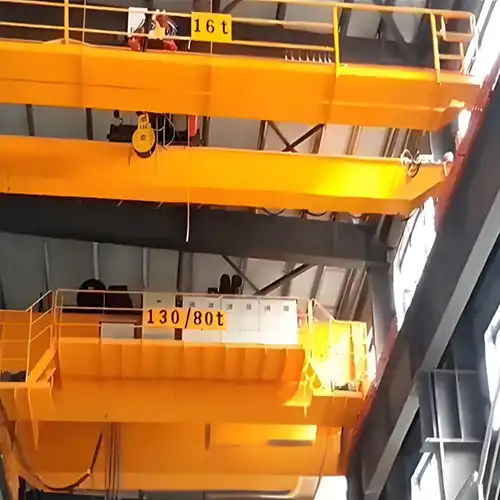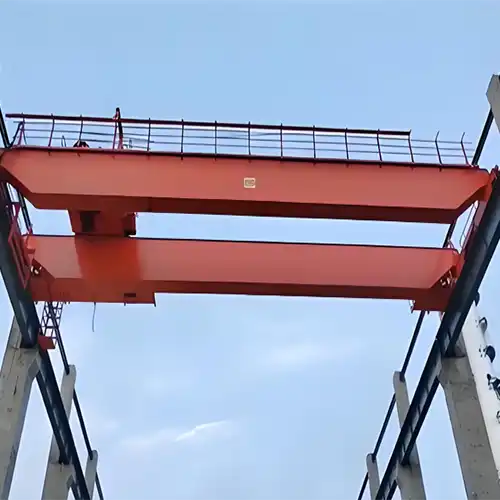Heavy-Duty Laminated Hook for Steel Plant: 120-Ton Hook Solution
Custom 120-ton laminated hook designed for steel mills, offering durability, high-temperature tolerance, and ease of maintenance for overhead cranes.
Category: Heavy Duty & Large Capacity
Your Trusted Heavy Duty Overhead Crane Hook Manufacturer & Supplier
120 Ton Overhead Crane Hook
A Case of Heavy-Duty Laminated Hook Customized for the Steel Industry
Introduction
In a steel plant, heavy lifting never stops. From red-hot ladles full of molten metal to large steel slabs and long billets—everything is heavy, dangerous, and needs to be moved carefully.
That's where a crane hook becomes one of the most important parts of the entire lifting system. It's not just a piece of metal—it carries the full load and protects both workers and equipment. The hook must be strong, reliable, and built to handle tough conditions.
Some jobs are too heavy for standard forged hooks. Especially in steel plants, where the loads are big and the lifting happens often. For this reason, laminated hooks are often a better choice.

This case is about a 120-ton laminated hook we designed for a steel mill's overhead crane. It wasn't off the shelf. It was made to fit the plant's exact needs, down to the smallest detail.
Key points:
- Industry: Steel manufacturing (billets, slabs, ladles)
- Challenge: Lifting extremely heavy and hot materials safely
- Solution: Custom-built laminated hook with 120-ton capacity
- Goal: Improve safety, reduce downtime, and increase hook life
This hook is more than strong—it's smartly designed to last longer and work better in the steel industry.
Industry Background and Project Overview
Sector: Large-Scale Integrated Steel Plant
The steel industry is all about heavy-duty operations. A large-scale integrated steel plant handles a lot of different processes, from the melt shop (where raw materials are turned into steel) to the rolling mill (where steel is shaped) and the billet handling area (where long steel pieces are moved). Each step involves massive, heavy materials that need to be lifted, transported, and placed precisely.
In these environments, the crane is the workhorse. It's the main tool for moving everything—from molten metal in ladles to slabs of steel being processed. The crane system has to be tough, reliable, and capable of running non-stop.
Application: High-Temperature, High-Cycle Lifting
In a steel mill, lifting operations are demanding, to say the least. These cranes lift ladles of molten metal that can reach temperatures above 1,500°C (2,732°F), steel slabs that weigh tons, and long billets that require precise handling. Every lift is high-stress, high-temperature, and often happens multiple times a day.
Because of the extreme working conditions, the crane hook system has to be designed for high-cycle usage. That means it must perform many lifts without failure, even under constant heavy loads and high heat. Replacing or repairing a hook can cause costly downtime, so everything has to be built to last.
Objective: Upgrade the Overhead Crane System
The goal of this project was clear: Upgrade the overhead crane to handle even heavier lifts more safely and efficiently. A standard hook just wouldn't cut it for the steel plant's needs. They required a high-capacity, durable hook system that would be able to handle extreme heat, high wear, and constant heavy lifting.
The key objectives for the new hook system were:
- Durability: To withstand extreme conditions and last longer.
- Safety: To ensure reliable operation and prevent failure under heavy loads.
- Ease of maintenance: To reduce downtime and make inspections simple.
This new laminated hook was designed specifically for these high demands, ensuring it would fit seamlessly into the existing crane setup and keep the plant running smoothly.
Why Laminated Hooks Suit Steel Mill Operations
Laminated hooks are a top choice for steel mills because they are designed to meet the extreme conditions of this industry. Here's why they perform so well:
High-Temperature Tolerance
Steel mills are hot, and the cranes work with molten metal, heated billets, and slabs. A laminated hook is made by stacking layers of high-strength steel, which allows it to better resist heat compared to a solid forged hook. The layered construction helps dissipate heat, making it more capable of withstanding the extreme temperatures typical in steel production environments.
- Benefit: The hook doesn't warp or weaken as easily under high heat, extending its life and performance in demanding conditions.
Resistance to Fatigue
Laminated hooks are built to endure continuous, high-load lifting, which is common in steel mills. Due to their design, laminated hooks are less prone to fatigue compared to single-piece forged hooks. Steel mills are high-demand environments, where cranes operate frequently, often lifting tons of steel at a time. The layers of a laminated hook spread the stress load, helping prevent cracks and failures that can occur with solid hooks under repeated use.
- Benefit: Increased reliability in high-cycle lifting tasks, reducing the chance of hook failure and the need for frequent replacements.
Ease of Inspection
One of the key advantages of laminated hooks is how easy it is to inspect for wear and tear. The layered construction allows operators to check each layer for signs of fatigue or damage without needing to disassemble the entire hook. In steel mills, where downtime is costly, having an easy inspection process helps keep the crane running smoothly and ensures safety.
- Benefit: Regular inspections are quicker and less expensive, making it easier to catch issues early before they lead to equipment failure.
Partial Repair and Replacement
Another advantage of laminated hooks over forged hooks is the ability to repair or replace individual layers. If one layer shows signs of wear, it can often be replaced without needing to replace the entire hook. This is especially valuable in the steel industry, where hooks are exposed to extreme conditions that can wear them down faster than in other industries.
- Benefit: A laminated hook is more cost-effective in the long run, as repairs and partial replacements extend its useful life.
Custom Hook Design Features
Rated Load Capacity: 120 Tons
This laminated hook was designed specifically for heavy lifting in a steel mill. With a 120-ton capacity, it's built to handle the heaviest loads—like ladles of molten metal or long billets. It's a perfect match for cranes used in steel processing and handling, where lifting capacity is critical.
- Benefit: It ensures safe, reliable operation even with the heaviest materials in the mill.

Construction: Precision-Cut Laminated Steel Plates
The hook is made from high-strength alloy steel plates, carefully cut and layered to create a robust, durable structure. These laminated layers give the hook its strength and resilience, which is vital for steel mill operations where hooks are exposed to extreme stress.
- Benefit: The construction improves both strength and fatigue resistance, making it more reliable over time.
Design Specifics
- Optimized for Limited Headroom: Steel mill buildings often have low clearance, which makes it tricky to install lifting systems. This hook was custom-designed to fit within the specific height restrictions of the mill. Its compact design ensures maximum lifting capacity without sacrificing space.
- Reinforced with High-Load Lugs and Safety Latch: The hook features reinforced high-load lugs that make it capable of safely lifting heavy, awkward loads. Plus, a safety latch ensures the load stays secure during transport, preventing any potential accidents during lifts.
- Optional Swivel Bearing for Load Alignment: Steel mill cranes need to align loads quickly and precisely. This hook can be equipped with a swivel bearing, which helps rotate the load smoothly and align it with the crane's hoisting system.
Surface Treatment
- Anti-Scale Coating for High-Temperature Zones: Given the heat in a steel mill, the hook is coated with an anti-scale layer to protect it from heat damage and slag buildup. This ensures the hook remains in top condition, even when handling molten metal or heated materials.
- Machined Wear Indicators: Over time, crane hooks can develop signs of wear, especially in high-stress areas. Machined wear indicators are added to the hook to make inspection easier. These indicators help operators identify areas that may need attention before a failure occurs.
Hook Block Integration in Steel Mill Crane
Integrating the 120-ton laminated hook into the crane system requires careful planning to ensure smooth and reliable performance. The hook is part of a hook block system and works together with other crane components to handle the heaviest loads in the steel mill.

Hook Installed in a Double Girder Overhead Crane
This hook is designed to work seamlessly with a steel mill double girder overhead crane—a common crane type in steel mills. The double girder setup allows for greater lifting capacity and stability, which is essential when handling massive steel loads. The 120-ton laminated hook is mounted within the hook block system of the crane, ready for use in demanding environments like ladle handling or billet lifting.
- Benefit: The double girder crane provides the support and stability needed to safely lift and transport extremely heavy loads.
4 or 6-Sheave Hook Block System
The hook block system is equipped with either 4 or 6 sheaves, depending on the lifting requirements and crane configuration. These sheaves (pulley wheels) guide the rope and help distribute the lifting load more evenly. The more sheaves in the system, the smoother the lifting operation, especially when handling heavy, awkwardly-shaped loads.
- Benefit: Multiple sheaves reduce the load on each pulley and rope, increasing lifting efficiency and reducing wear and tear.
Heat-Resistant Ropes and Pulley Bearings
Steel mill cranes are used in high-temperature environments, so it's essential to use heat-resistant ropes and pulley bearings. These materials are specially designed to withstand the extreme conditions found in the steel industry. The ropes can carry heavy loads without stretching or breaking, and the pulley bearings perform reliably, even under heat exposure.
- Benefit: Heat-resistant materials ensure that the crane continues to function smoothly, even when exposed to high temperatures, preventing premature wear and reducing maintenance needs.
Rotating Mechanism to Align with Load Orientation
Steel mill cranes often need to rotate the hook and load to align it properly during lifting. This is where a rotating mechanism comes in handy. It allows the hook to rotate and align the load exactly where it's needed. This feature is especially useful when dealing with large or irregularly shaped materials like billets and slabs.
- Benefit: The rotating mechanism improves the precision of every lift, making it easier to handle difficult or heavy loads without causing damage.
Compatibility with Electromagnetic Lifting Attachments or Spreader Beams
Steel mills often use electromagnetic lifting attachments to handle hot, steel billets, or slabs. The 120-ton laminated hook is designed to be compatible with these attachments, allowing for quick switching between different lifting methods. Additionally, the hook can be used with spreader beams, which help distribute the load evenly and keep the load stable during transport.
- Benefit: This versatility makes the crane more adaptable to different types of loads, ensuring that it can handle whatever the mill needs to lift.
Testing and Quality Assurance
Before any crane hook leaves the factory, it undergoes rigorous testing to ensure it meets the highest standards for safety and performance, especially for steel mill applications. Here's a breakdown of the key tests:
150% Overload Test
The hook is subjected to an overload test where it's stressed to 150% of its rated load. This simulates extreme conditions to verify the hook's ability to safely handle loads beyond its capacity in emergency situations. This test ensures the hook can manage unexpected weight increases without failure.
- Benefit: This guarantees that the hook can withstand overloads during operation without compromising safety.
Dynamic Load Cycle Simulation
To test how the hook performs under continuous, high-cycle lifting conditions, a dynamic load cycle simulation is conducted. This test mimics the repetitive lifting operations in the steel mill, checking the hook's ability to handle the constant wear and stress of everyday use.
- Benefit: The test ensures the hook can perform reliably over the long term without fatigue or failure.
Ultrasonic and Magnetic Particle Inspection of Laminations
The laminated steel plates that make up the hook are thoroughly inspected using ultrasonic testing and magnetic particle inspection. These methods check for any internal flaws or surface cracks that could affect the hook's strength. The inspections help catch potential issues before they become a problem.
- Benefit: This ensures that every layer of the hook is sound and capable of performing under heavy loads.
Third-Party Certification
The hook is certified by third-party testing organizations like SGS and TÜV to confirm that it meets international standards. These certifications provide independent verification that the hook complies with all safety regulations and quality requirements.
- Benefit: Third-party certification adds an extra layer of assurance, guaranteeing that the hook meets or exceeds industry expectations.
Compliance with ISO, FEM, and Steel Industry Lifting Standards
The hook is designed and tested to conform to global standards such as ISO (International Organization for Standardization) and FEM (European Federation for Materials Handling). Additionally, it meets the specific safety and performance requirements for steel industry lifting equipment.
- Benefit: Compliance ensures the hook is safe, reliable, and legal for use in steel mill environments.
Manufacturing and Delivery Timeline
We understand that time is critical when upgrading equipment in a steel plant. That's why we focus on fast, efficient manufacturing and delivery. Here's what the process looks like:
Custom Fabrication Timeline: 4–6 Weeks
The fabrication of a custom 120-ton laminated hook typically takes 4–6 weeks depending on the complexity and specifications required. During this time, the hook is designed, manufactured, tested, and inspected to meet the mill's exact needs.
- Benefit: A quick turnaround time minimizes the downtime in the steel plant and gets the hook up and running faster.
Delivery Options: Assembled Hook Block or Separate Components
The hook is delivered as either a complete assembled hook block or separate components for easy assembly at the steel plant. The choice depends on the crane setup and the plant's preference for on-site assembly or pre-assembly.
- Benefit: Flexibility in delivery options allows for easier installation and faster setup, depending on the customer's needs.
Full Documentation Included
When the hook is delivered, it comes with a complete set of documentation, ensuring that the steel mill can easily install, operate, and maintain the equipment:
- Technical Drawings: Detailed diagrams of the hook's design and components for proper installation.
- Load Test Reports: Documentation of all load testing, verifying that the hook has passed all safety and performance tests.
- Maintenance and Inspection Manual: A guide that helps steel mill operators perform regular checks, maintenance, and inspections to keep the hook in top working condition.
- Benefit: The full documentation ensures easy installation, proper maintenance, and long-term performance, making it easier for the steel mill team to keep everything running smoothly.
Summary:
- Rigorous testing: Overload, dynamic load cycles, and detailed inspections ensure safety and durability.
- Third-party certifications: Verify compliance with international standards.
- Fast fabrication: Custom hooks ready in 4–6 weeks with flexible delivery options.
- Comprehensive documentation: Includes everything needed for proper installation and ongoing maintenance.
By ensuring top-tier testing, quality control, and efficient delivery, we provide a crane hook solution that will stand up to the harshest conditions in the steel industry.
On-Site Performance and Client Feedback
Once the 120-ton laminated hook was installed in a 120-ton ladle crane operating in a hot metal bay, it quickly demonstrated its ability to handle the harsh conditions of steel production. Here's an overview of the performance after 6+ months of operation:
Installed in a 120-Ton Ladle Crane Operating in a Hot Metal Bay
The hot metal bay is one of the most demanding areas in a steel plant. The crane handles ladles filled with molten metal, which require both strength and resilience from the hook. The laminated design was specifically chosen for this crane because it can withstand extreme temperatures and constant high-load lifting.
- Benefit: The laminated hook is perfectly suited for these extreme conditions, ensuring that the crane can operate safely and efficiently.
Performance After 6+ Months:
- Excellent Fatigue Resistance: After over six months of continuous use, the laminated hook showed outstanding resistance to fatigue, even with frequent lifting of heavy, high-temperature loads. This durability ensures a long lifespan and helps avoid premature failures, which can lead to costly downtime.
- Simplified Inspection Process During Shutdowns: The hook's design features, like machined wear indicators, made inspections quick and easy during scheduled maintenance shutdowns. The ability to spot potential wear or damage early helped keep the crane operating smoothly, reducing the need for unscheduled maintenance.
- Client Report: Improved Safety, Fewer Hook-Related Stoppages: The client's feedback highlighted improved safety and fewer hook-related stoppages. The hook's robust design and easy-to-inspect features contributed to a more reliable lifting operation. Since the hook was built to handle the stresses of high-temperature lifting, the risk of accidents or failures was greatly reduced.
- Benefit: These improvements not only boosted safety but also helped the plant avoid costly downtime and keep production on schedule.
Buyer Insights: When Steel Mills Should Choose Laminated Hooks
When considering overhead crane hooks for steel mill operations, there are specific conditions where laminated hooks provide the most benefit. Here are key scenarios where laminated hooks make the best choice:
Lifting Operations Above 100 Tons, Especially Repetitive or High-Risk Tasks
Steel mills that regularly handle heavy loads over 100 tons—such as ladles of molten metal or long billets—require hooks that can withstand high stress and repetitive cycles. Laminated hooks are designed to handle these intense lifting operations without compromising performance.
- Benefit: Laminated hooks can endure the constant fatigue of heavy-duty lifting, providing more reliable and safer operations.
Harsh Working Environments (Dust, Scale, Heat, or Slag Splash)
The steel industry is a challenging environment filled with extreme heat, slag splash, dust, and scale. Laminated hooks are ideal for these harsh environments because they have been specifically designed to resist heat damage, abrasion, and corrosion.
- Benefit: The laminated design's ability to resist extreme temperatures and environmental factors ensures longevity and minimal downtime.
Maintenance-Focused Plants Needing Easier NDT and Part Replacement
Steel mills that focus on preventive maintenance or need to make repairs quickly will appreciate the easier non-destructive testing (NDT) and partial part replacement options that come with laminated hooks. Unlike traditional forged hooks, laminated hooks allow for localized repairs, which makes them more cost-effective for long-term use.
- Benefit: The simplified maintenance process lowers operational costs and helps minimize the downtime usually required for full hook replacements.
Projects Requiring Cost-Effective, Durable Solutions with Proven Safety
When working on a high-capacity lifting project that needs a cost-effective solution with proven durability and safety, laminated hooks are an excellent choice. Their layered construction provides both strength and flexibility at a more affordable price than traditional forged hooks.
- Benefit: Steel mills get the best of both worlds—affordable durability and enhanced safety for high-risk operations.
Summary:
- Laminated hooks are ideal for heavy-duty lifting in high-risk, high-cycle operations.
- They provide excellent performance in harsh environments with heat, slag, and debris.
- The hooks allow for easy maintenance, part replacement, and non-destructive testing, reducing overall costs.
- Laminated hooks offer a cost-effective, durable solution with proven safety and longevity.
For steel mills looking to enhance safety and efficiency while keeping maintenance simple, laminated hooks offer a long-lasting and reliable solution.
Contact Us
Looking for a heavy-duty hook solution for your steel mill crane?
We specialize in providing custom-made laminated hooks designed to handle the most demanding steel mill operations. Whether you need a hook for lifting ladles, billets, or slabs, we've got you covered with durable, high-performance solutions.
What We Offer:
- Custom Laminated Hooks: Available in capacities ranging from 50 to 200 tons, tailored to your specific needs.
- Design Support: Our expert team will work with you to create the best solution for your crane system, ensuring safety and efficiency.
- Fast Production and Worldwide Delivery: We pride ourselves on quick turnaround times and deliver our products worldwide, ensuring minimal downtime for your operations.
Request a Free Design Review and Quotation Today
Don't wait for the next lifting challenge to arise—contact us now for a free design review and quotation. Let us help you find the perfect hook solution that fits your crane, production requirements, and budget.
Feel free to reach out if you need any adjustments or further details in this section!
Main Projects
Related Products
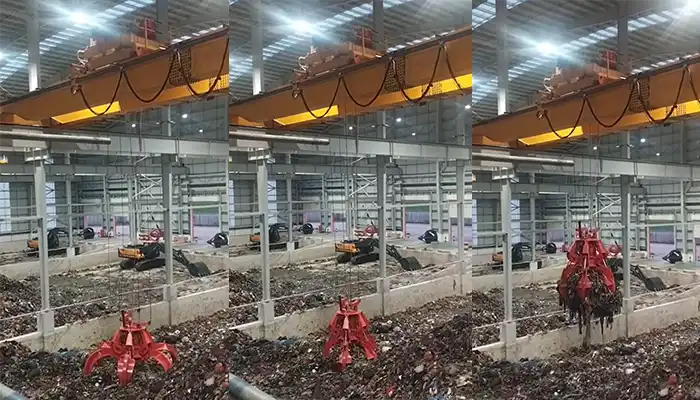
Supplied three grab bucket crane kits to Indonesia, enhancing garbage handling efficiency with high load capacity and reliable performance.
Free consultation to Confirm Parameters & Specifications and Get
Latest Crane Price & Crane Rate.
- Types of overhead cranes : _______?
- Optional: Overhead travelling crane, goliath gantry crane,Slewing jib crane, Single girder or double girder crane,small portable crane or kbk crane, etc.
- Capacity of overhead crane: _______?
- Optional: 0.25ton, 0.5 ton, 1 ton, 2 ton, 3ton, 5 ton, 10 ton,15ton, 20ton, 25 ton, 30ton,35ton, up to 550ton, etc.
- Crane span & lifting height : _______?
- Crane travelling length : _____?
- Control of overhead crane:_______?
- Optional: pendant/ remote/cabin control
- Voltage supply of overhead crane:_____?
- Eg,: 380V50/60HZ,3Phase or others,etc.
- Application/usage of crane:_______?
- Eg,: Steel mill, ,injection mold, cement,stone, concrete,granite, general manufacturing, etc.
Just leave a message via the contact form and our hoist and crane engineer will contact you with in 24working hours.
Get In Touch
